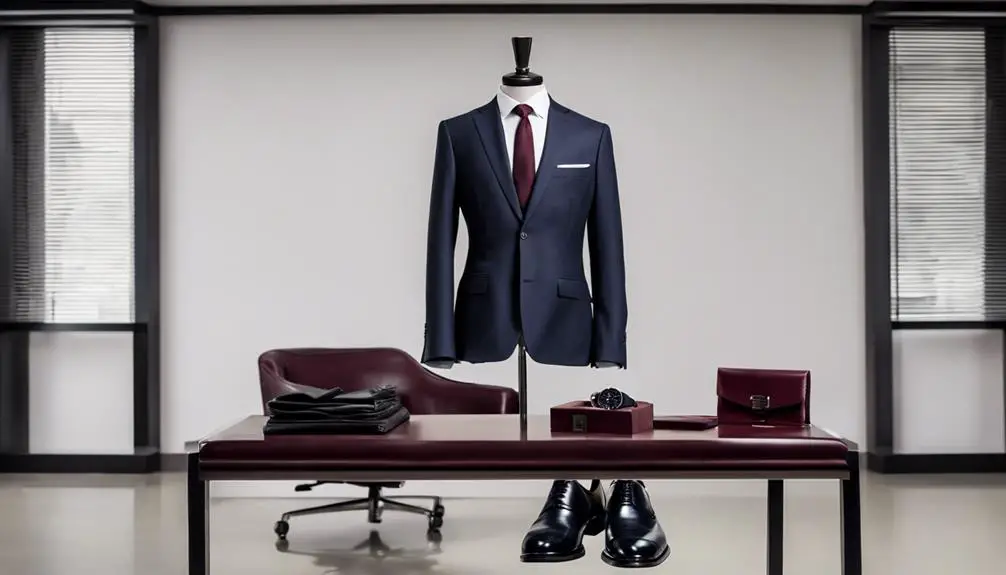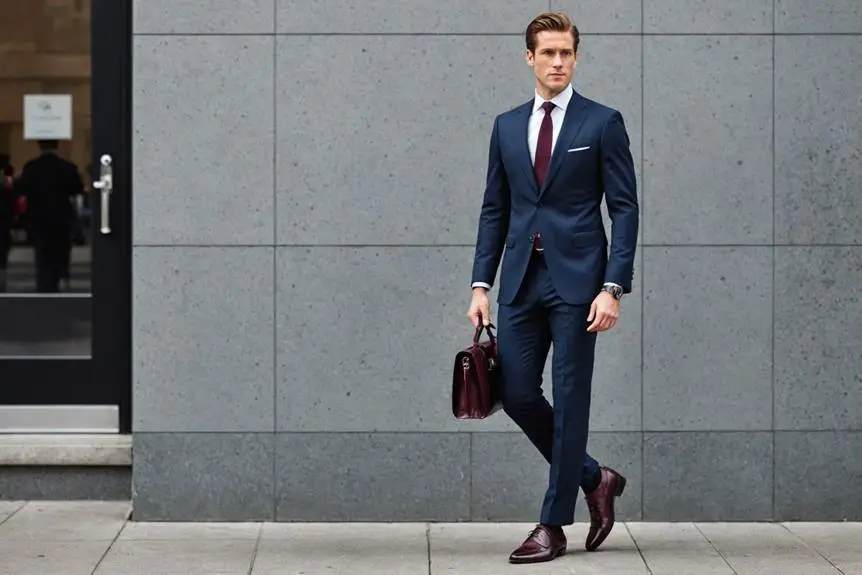To dress like an investment banker, you'll want a wardrobe that screams professionalism and sharp elegance. Start with 2-3 tailored suits in medium-to-dark gray or navy. Pair these with long-sleeve dress shirts, ideally in classic white or light blue, which convey authority. Add conservative silk ties and polished leather shoes—black or brown are best. For women, tailored skirts or pantsuits also shine in those classic colors. Remember, on casual days, stick to well-fitted attire—avoid sneakers or jeans. When you nail this attire, you'll not only look the part but feel it too, and there's more to explore on this topic!
Understanding the Investment Banker Dress Code

What makes the investment banker dress code so important? In the world of banking, your attire speaks volumes before you even say a word. A well-fitted navy blue suit can set the tone for your professional image, showcasing your commitment and attention to detail. Investment bankers are expected to adhere to a business formal dress code that reflects their high-stakes environment. Medium-to-dark gray or navy suits are the standard, while lighter colors like brown often miss the mark in a professional setting.
When it comes to dress shirts, long-sleeve options in white or light blue are your best bets. These choices project a sense of authority and competence, essential in such a competitive field. Women, on the other hand, can choose from elegant skirts or pantsuits in similar conservative colors, paired with low-heeled, polished shoes that maintain a professional look.
Accessories play an important role too. You'll want to keep them minimal—think a conservative silk tie for men and tasteful jewelry for women. The focus should remain on your overall appearance, enhancing your professional image rather than overshadowing it.
Even on casual Fridays, you can't let your guard down completely. Men should still steer clear of jeans and T-shirts, while women can opt for trousers or knee-length skirts paired with blouses. Remember, dressing appropriately is more than just a guideline; it's a pathway to career success in investment banking.
Essential Attire for Men
To succeed in the investment banking world, you'll often find yourself reaching for a well-fitted suit in medium-to-dark gray or navy. These colors exude professionalism and are staples in the wardrobes of successful investment bankers. Here's how to nail your essential attire:
- Suits: Invest in 2-3 well-fitting business suits. The fit is vital, so consider getting them tailored for that polished appearance.
- Shirts: Make certain you have at least one classic white shirt and one light blue shirt. These timeless options are perfect for meetings and create a sophisticated look.
- Ties: Select conservative silk ties in solid colors or a maximum of three colors. Avoid loud patterns to maintain a refined, professional vibe.
- Dress Shoes: Choose low-heeled, polished black or brown dress shoes. Casual footwear isn't acceptable in formal settings, so ensure your shoes complement your suits.
Limit accessories to just a matching belt, a watch, and minimal jewelry. This understated approach keeps your overall appearance sharp and focused on professionalism. While business casual is becoming more accepted in some settings, sticking to these essentials will help you stand out in any situation.
Key Clothing Choices for Women

An investment banker's wardrobe should reflect professionalism and confidence, especially for women maneuvering this competitive field. When curating your investment banker wardrobe, aim for skirts or pantsuits in navy or medium-to-dark gray. These colors exude authority and sophistication, setting the tone for a polished appearance. Tailoring is essential; well-fitted clothing enhances your overall look and conveys seriousness and competence—a must in the fast-paced world of finance. Consider using tailoring techniques for tops to guarantee your blouses and jackets fit impeccably.
For footwear, opt for low-heeled conservative dress shoes that coordinate seamlessly with your outfit. Pairing these with skin-colored hosiery not only completes your ensemble but also adds an extra layer of professionalism. When it comes to jewelry, you have a bit more leeway compared to your male counterparts. Choose tasteful and moderate options, steering clear of anything too flashy; this isn't the time for bold statements, after all.
Keep accessories minimal—think a classic watch rather than trendy items that might distract from your professional image. Remember, the goal is to project confidence without overwhelming your audience.
Navigating Business Casual Guidelines
Maneuvering business casual guidelines in the investment banking world requires a keen understanding of professionalism balanced with comfort. While the environment may feel relaxed, your attire should always reflect a polished image. Here's how to navigate the banking dress code effectively:
- Choose Well-Fitted Clothing: Your investment banking wardrobe should consist of tailored pieces. Guarantee your trousers or skirts fit well and are clean, avoiding overly casual items like sneakers.
- Opt for Subtle Patterns: When selecting shirts, checkered patterns can be a good choice, but steer clear of loud colors or prints. Subtlety in patterns shows a professional appearance that resonates with your colleagues.
- Minimal Accessories Matter: Keep accessories to a minimum. Men should wear a conservative belt that matches their shoes, while women can select tasteful jewelry, avoiding anything too flashy. This approach maintains an elegant vibe.
- Dress Socks Are Essential: Don't forget about dress socks! They should complement your outfit, adding to the overall cohesiveness of your business casual attire.
Tips for Building a Professional Wardrobe

Building a professional wardrobe doesn't have to be overwhelming, especially when you focus on key pieces that offer versatility and style. Start with a good suit; investing $400 to $1,000 for a quality option is crucial. Aim for at least two versatile suits in classic colors like navy blue and gray, as these will give you a polished look suitable for Wall Street and beyond.
Next, stock up on 4 to 8 well-fitted dress shirts. White and light blue options work best, as they pair effortlessly with your suits and allow you to nail that financial modeling presentation without a hitch. Don't forget to grab at least three ties in conservative colors, as they can elevate your entire outfit and keep you aligned with professional expectations.
Quality dress shoes are non-negotiable. Allocate funds for two pairs—one black and one brown. These will serve you well, whether you're heading to a meeting or networking event. Accessories also play a crucial role; invest in sturdy belts and dress socks that match your shoes to complete each look seamlessly.
Frequently Asked Questions
What Color Suits Do Investment Bankers Wear?
Investment bankers typically wear medium-to-dark gray or navy suits, focusing on solid colors for a professional appearance. Consider fabric choices and tailoring tips to enhance client impressions; accessorize conservatively while maintaining seasonal variations in style trends.
What Is the Dress Code for JP Morgan Investment Banker?
"Clothes make the man." At JP Morgan, you'll need professional attire that includes tailored suits, conservative shirts, and polished shoes. Embrace wardrobe essentials that align with corporate culture, keeping grooming standards and seasonal trends in mind.
What Is the Dress Code for Goldman Sachs Investment Banking?
At Goldman Sachs, you'll need to embrace corporate attire with business casual flexibility. Focus on color coordination, choose dress shoes wisely, and maintain professional grooming, while adjusting accessories choices for formal occasions in the office environment.
Do Investment Bankers Wear Suits Every Day?
Sure, suits signify seriousness! In investment banking, daily dress codes lean towards formal. Casual attire's rare, reflecting corporate culture and industry expectations. Balancing personal branding and networking events, you'll often opt for tailored office accessories instead.




